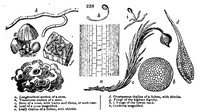1020. Cellulares, Cryptogamous, or Acotyledonous, plants, are all, therefore, different terms denoting the same combination of vegetables. The first term is here adopted in preference to the others, as expressing the most obvious character upon which the division depends, namely, the cellular, not vascular, structure of the plants composing it. Cellular plants are formed entirely of cellular tissue (fig. 238.), without spiral vessels; or, in more familiar terms, by having no veins in their leaves if foliaceous, and not forming wood; they also are destitute of perfect flowers. The lower tribes, such as Fungi and A'lgï¾µ, are destitute of leaves, and in some points approach the animal kingdom so nearly as to be scarcely distinguishable. In the highest tribe, Ferns, apparent veins are formed in the leaves; but as they are not supplied with spiral vessels, they cannot be considered more than analogous to the veins of other plants. Ferns, however, hold the intermediate station between Cellulares and Vasculares, and are chiefly retained among the former on account of their perfect accordance in other respects. In the whole of Acotyledons, it is unnecessary to examine the seed for the purpose of determining whether it has one cotyledon, several cotyledons, or none, the structure of the perfect plant giving the most obvious and satisfactory evidence.

